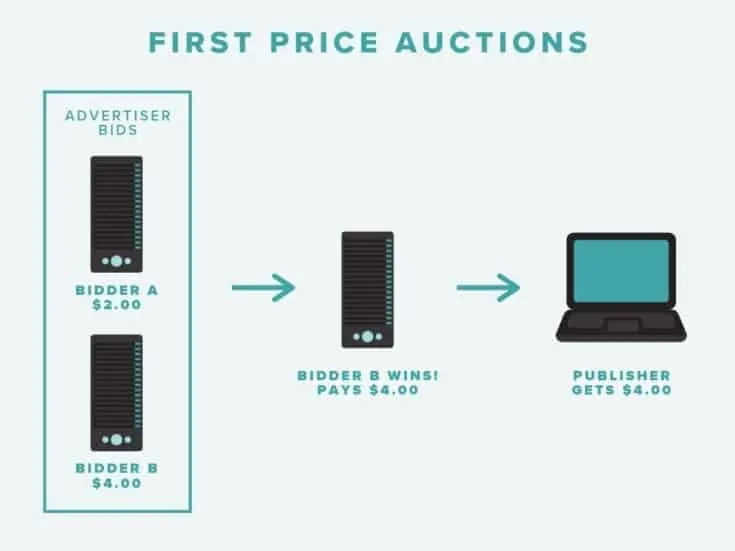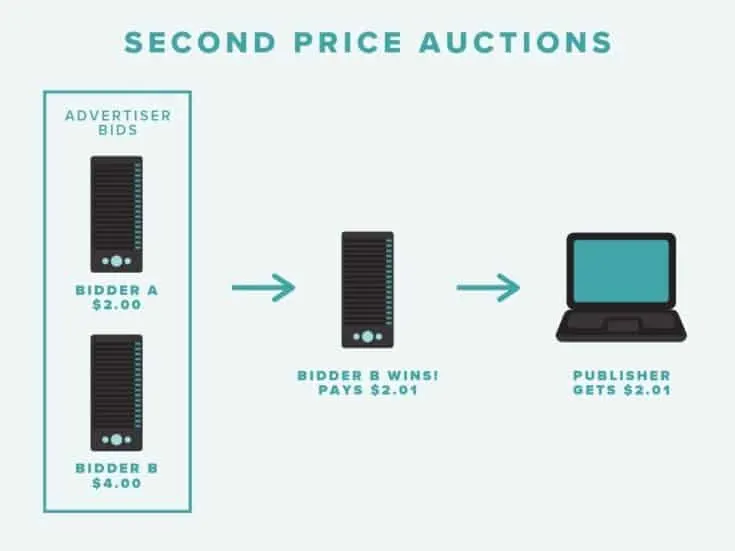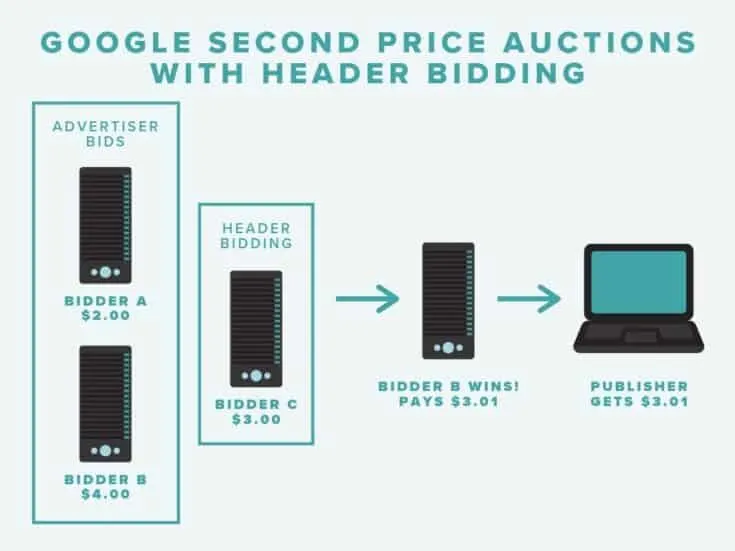Google First Price Auction: What it Means For Publishers


Six months after announcing an overhaul of its auction dynamics, Google has finally begun moving most traffic from a second price auction to a first price auction in Google Ad Exchange, Google Ad Manager, and other ad products.
What does that even mean? How will it impact Mediavine publishers and the industry in general? We’re here to break it down.

In a first price auction:
It’s really the simplest of auctions.
An example of a first price auction: Bidder A submits a $2.00 bid. Bidder B submits a $4.00 bid. Bidder B wins and pays $4.00.

A second price auction is a little different.
Our original example, in a second price auction: Bidder A submits a $2.00 bid. Bidder B submits a $4.00 bid. Bidder B wins, but pays only $0.01 more than its closest competition. So Bidder B wins and pays $2.01.
Using our simple example, the publisher would be paid $4.00 for those impressions in a first price auction and $2.01 in a second price auction. While first price obviously seems better at a glance, it’s not that simple.
Sophisticated publishers such as Mediavine develop flooring strategies around second price auctions, and in the world of header bidding, there isn’t just one second price auction – there’s actually multiple auctions.
For example, we conduct a round of header bidding auctions in addition to the second price scenario above. We’d first run our header bidding auctions, then submit that bid into the same second price Google auction.

So let’s say there’s a Bidder C who submits a $3.00 bid and wins our header bidding auction. We submit that into the mix, and Bidder A would have to pay $3.01 for winning the auction, not $2.00.
Yes, the first price auction bid was $4.00, but again, it’s not that simple.
In a first price auction, advertisers aren’t willing to bid as high, knowing they’ll be on the hook for the full amount if they win. Remember, in a second price auction, a $4.00 bid can be made strategically, designed to win the impression, but only pay $2.01.
Second price auctions allow advertisers to bid more, yet pay less.
In first price auctions, the more realistic bid would be closer to the neighborhood of $2.01, or the amount that ends up being paid. Advertisers use a technique known as “bid shading” to get as close to that $2.01 as possible.
So now let’s go back to the original scenario. In a first price auction, Bidder A would win closer to $2.01, but in a second price auction, they won at $2.50 due to header bidding.
Knowing that the highest bid might be much higher than the second price bid (or that there may not be a second bid), Mediavine and other sophisticated publishers work out flooring strategies that determine a “floor”, or the minimum bid a publisher will allow.
Example: If a floor of $2.50 is set, the highest bid of $4.00 would pay $2.50 instead of $.01 over the second highest bid of $2.00, capturing $0.49 more value.
Knowing that the highest bid might be much higher than the second price bid (or that there may not be a second bid), Mediavine and other sophisticated publishers work out flooring strategies that determine a “floor”, or the minimum bid a publisher will allow.
If a floor of $2.50 is set, the highest bid of $4.00 would pay $2.50 instead of $0.01 over the second highest bid of $2.00, capturing $0.49 more value.
In short, second price auctions are more complicated, but offer more opportunities for publishers to try to extract value from the spread – the amount between the second highest and highest bid.
Not necessarily. Second price auctions aren’t the greatest fit in a header bidding world. Publishers enjoyed benefits at the margins as described above, but from an advertiser standpoint, second price doesn’t make much sense.
Google sees the move to a single, unified first price auction system as fairest to all parties and the path to a healthier ecosystem in the long run.

We know that’s the biggest, or only question on your minds. First off, it’s important to note that only Google is shifting to first price now. Most of our exchange partners already adopted this format last year or the year before.
Google is our largest ad partner, but the impact should still be fairly small.
We anticipate a small RPM increase at the onset while advertisers learn the system and learn what they’re comfortable bidding and paying. After the dust settles in the ensuing months and years, we see RPMs leveling out around where they’ve been in the second price landscape.
In short, you likely won’t even see a significant RPM change attributable to this.
Of course. As a Google Certified Publishing Partner, we’ve been in constant contact with Google over the past year to ensure we’re optimized for this change. Internally, we’ve worked extensively behind the scenes to refine our auction specifications.
Our flooring strategies are constantly adapting and evolving to changes in the industry, and this is no different.
We’ve already made adjustments in our ad server to handle Google’s new mechanisms for first price auctions, including tools such as Unified Pricing Rules and Protections – things you don’t have to think about because we do.
In short, Mediavine should be uniquely positioned to absorb this change without publishers needing to worry. As a full service ad management provider, our goal is always to adapt, optimize and help you grow your businesses regardless of the inevitable industry shakeups.
Stay up to date with the latest from Mediavine
 Brad Hagmann
Brad Hagmann
“Let’s talk about politics.” We know. This is a phrase absolutely no one wants to hear uttered around the dinner table or backyard barbecue these days. But hear us out. …
 Brad Hagmann
Brad Hagmann
It seems hard to believe that we’re more than a month into a new year, and with it, a new and ever-changing technological landscape. Looking back on the previous year, …
 Brad Hagmann
Brad Hagmann
Ah, July. It’s a glorious month of sand-filled swimsuits, mosquito invasions, broken air conditioners and applying sunscreen only to look like cooked lobsters. It’s also the start of a new …